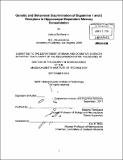| dc.contributor.advisor | Susumu Tonegawa. | en_US |
| dc.contributor.author | Sariñana, Joshua, Jr | en_US |
| dc.contributor.other | Massachusetts Institute of Technology. Dept. of Brain and Cognitive Sciences. | en_US |
| dc.date.accessioned | 2012-01-12T19:26:29Z | |
| dc.date.available | 2012-01-12T19:26:29Z | |
| dc.date.copyright | 2011 | en_US |
| dc.date.issued | 2011 | en_US |
| dc.identifier.uri | http://hdl.handle.net/1721.1/68424 | |
| dc.description | Thesis (Ph. D.)--Massachusetts Institute of Technology, Dept. of Brain and Cognitive Sciences, 2011. | en_US |
| dc.description | Cataloged from PDF version of thesis. | en_US |
| dc.description | Includes bibliographical references. | en_US |
| dc.description.abstract | Dopamine (DA) containing neurons project throughout the brain. DA has been implicated in mediating brain disorders such as Schizophrenia, Parkinson's disease, Huntington's disease and drug addiction. The role of DA in working memory and procedural learning is also well established. DA is a ubiquitous neurotransmitter that affects much of the brain, but very little is known how dopamine functions in hippocampal dependent learning. It was only until recently that dopamine-containing neurons were found to project to the hippocampus. Even less understood are the expression patterns of DA receptors within the hippocampus and this is underlined by the inability of distinguishing the dopamine 1 receptor family (D1 and 5 receptors (D1/D5Rs)). Given the interaction of the D1 family with similar G-protein coupled receptors it has been assumed that these two receptors function in an analogous fashion. Additionally, the specific expressional pattern of each receptor lacks clarity due to non-specific binding by molecular probes. Moreover, D1 and D5 pharmacological and global KO studies cannot and have not functionally delineated D1Rs from D5Rs and global KOs of the D1Rs or D5Rs are not specific to the hippocampus, thus compensatory mechanisms likely ameliorate most physiological and behavioral deficits. Still, the aforementioned studies do point to the D1 family in modulating hippocampal synaptic plasticity, learning and memory consolidation. In order to characterize D1Rs distinctly from D5Rs we have generated three strains of conditional mutant mice (D1 KO, D5 KO, D1/5 KO). I present data that shows distinct expression patterns within the hippocampus, the importance of D1 Rs and D5Rs in modulating hippocampal plasticity, and hippocampal dependent learning. These data highlight distinct functional roles of D1Rs and D5Rs in hippocampal function. | en_US |
| dc.description.statementofresponsibility | by Joshua Sariñana Jr. | en_US |
| dc.format.extent | 191 p. | en_US |
| dc.language.iso | eng | en_US |
| dc.publisher | Massachusetts Institute of Technology | en_US |
| dc.rights | M.I.T. theses are protected by
copyright. They may be viewed from this source for any purpose, but
reproduction or distribution in any format is prohibited without written
permission. See provided URL for inquiries about permission. | en_US |
| dc.rights.uri | http://dspace.mit.edu/handle/1721.1/7582 | en_US |
| dc.subject | Brain and Cognitive Sciences. | en_US |
| dc.title | Genetic and behavioral discrimination of dopamine 1 and 5 receptors in hippocampal dependent memory consolidation | en_US |
| dc.type | Thesis | en_US |
| dc.description.degree | Ph.D. | en_US |
| dc.contributor.department | Massachusetts Institute of Technology. Department of Brain and Cognitive Sciences | |
| dc.identifier.oclc | 768771619 | en_US |

